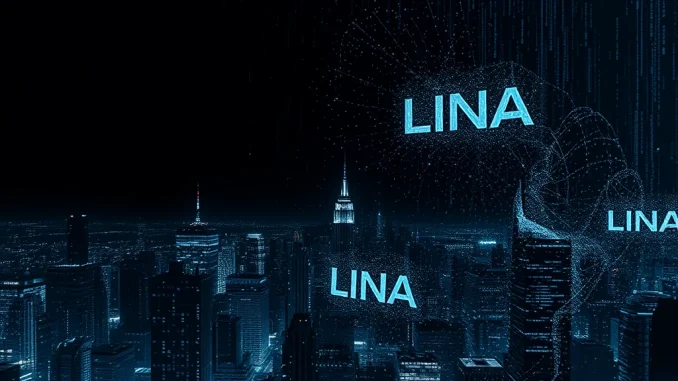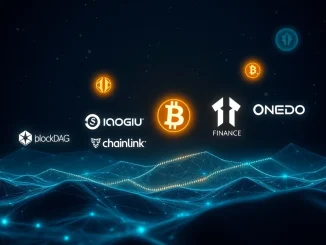
In a dramatic turn of events that has sent ripples through the decentralized finance (DeFi) space, Linear Finance (LINA), a protocol known for its synthetic asset offerings, has announced its immediate cessation of operations. The news, delivered via an official statement on X, cites unsustainable revenue generation as the primary catalyst for this abrupt crypto shutdown. For users and investors within the decentralized finance ecosystem, this development raises critical questions about the viability of DeFi protocols and the inherent risks within the volatile cryptocurrency market.
Why is Linear Finance Shutting Down? Understanding the DeFi Protocol’s Challenges
Linear Finance (LINA) positioned itself as a cross-chain compatible, decentralized synthetic asset protocol. Its aim was to allow users to gain exposure to a wide range of assets, including cryptocurrencies, commodities, and even traditional market indices, all within the DeFi realm. However, despite its innovative approach, Linear Finance faced significant headwinds in achieving financial sustainability. The official statement pointed to “ongoing challenges in generating sustainable revenue” as the core reason for the crypto shutdown.
Let’s break down the potential challenges faced by Linear Finance and other DeFi protocols in the current landscape:
- Market Volatility: The cryptocurrency market is notorious for its extreme volatility. Protocols reliant on trading volume or asset values for revenue can be severely impacted during bear markets or periods of low trading activity.
- Competition in the DeFi Space: The DeFi sector is intensely competitive, with numerous protocols vying for user attention and liquidity. Standing out and attracting sufficient users to generate sustainable revenue is a constant battle.
- Regulatory Uncertainty: The evolving regulatory landscape for cryptocurrencies and DeFi adds another layer of complexity and risk. Uncertainty can deter institutional adoption and impact user confidence.
- Smart Contract Risks: While DeFi promises decentralization and security, smart contract vulnerabilities remain a concern. Exploits and bugs can lead to significant financial losses, damaging user trust and protocol reputation.
- Gas Fees and Scalability Issues: High gas fees on certain blockchains, particularly Ethereum, can hinder user adoption and increase the cost of using DeFi protocols, impacting revenue generation.
LINA Token and User Impact: What Happens Now?
The immediate cessation of operations for Linear Finance has direct implications for holders of the LINA token and users of the protocol. While specific details regarding asset recovery or potential next steps are awaited, the announcement itself suggests a complete winding down of the project.
Here’s what users and token holders should consider:
- Token Delisting: Expect LINA tokens to be delisted from cryptocurrency exchanges. Trading activity is likely to diminish rapidly, and holding LINA tokens may become increasingly illiquid.
- Protocol Shutdown: The Linear Finance platform and its associated services will likely be shut down. Users should cease any interaction with the platform and be cautious of potential scams or phishing attempts.
- Loss of Funds: While it’s not explicitly stated, the cessation of operations raises concerns about the potential loss of funds for users who had assets locked within the Linear Finance protocol. It’s crucial to monitor official announcements for any information regarding asset recovery or compensation plans, though such outcomes are not guaranteed in DeFi project shutdowns.
- Community Support Channels: Engage with the Linear Finance community through official channels like their X account or Discord (if still active) for any updates or shared information.
[img] [/img] Linear Finance (LINA) announces cessation of operations due to unsustainable revenue.
The Broader Implications for Decentralized Finance
The Linear Finance shutdown serves as a stark reminder of the challenges and risks inherent in the DeFi space. While DeFi offers exciting possibilities for financial innovation and accessibility, it is not without its vulnerabilities. This event underscores several critical points for the future of decentralized finance:
- Sustainability is Key: DeFi protocols must prioritize sustainable revenue models to ensure long-term viability. Relying solely on hype or speculative trading volume is not a recipe for success.
- Risk Management is Paramount: Users engaging with DeFi protocols must understand and manage the risks involved, including smart contract risks, market volatility, and project failure.
- Due Diligence is Essential: Thorough research and due diligence are crucial before investing in or using any DeFi protocol. Evaluate the project’s fundamentals, team, tokenomics, and risk factors.
- Regulation and Maturity: As the DeFi space matures, regulatory frameworks will likely evolve. This may bring more stability and user protection but could also impact the decentralized nature of some protocols.
What’s Next for DeFi? Lessons from the Crypto Shutdown
The crypto shutdown of Linear Finance is undoubtedly a setback for the project and its users. However, it also presents valuable learning opportunities for the broader DeFi ecosystem. It highlights the need for greater emphasis on sustainable business models, robust risk management practices, and user education within the decentralized finance sector.
While the news is disheartening for those invested in Linear Finance, the core principles and potential of DeFi remain strong. The industry will likely learn from this experience, pushing towards more resilient, sustainable, and user-centric protocols in the future. The key takeaway is that the DeFi revolution is still in its early stages, and navigating its complexities requires both innovation and a healthy dose of caution.
Conclusion: A Wake-Up Call for DeFi and Its Users
The unexpected crypto shutdown of Linear Finance is a significant event in the DeFi narrative. It serves as a powerful reminder that even in the rapidly evolving world of decentralized finance, success is not guaranteed. For users, it reinforces the critical importance of due diligence and risk awareness. For developers and protocol creators, it underscores the necessity of building sustainable and resilient platforms. While the immediate impact is undoubtedly negative for those involved with Linear Finance, the long-term lessons learned from this event could contribute to a more robust and mature DeFi ecosystem. The future of decentralized finance hinges on its ability to learn from both its successes and its failures, ensuring a more secure and sustainable path forward.



